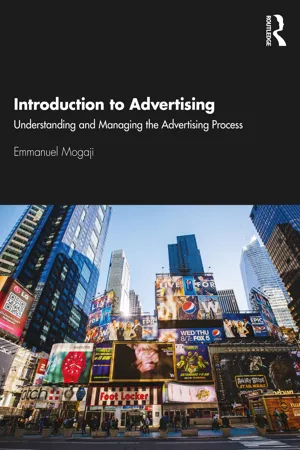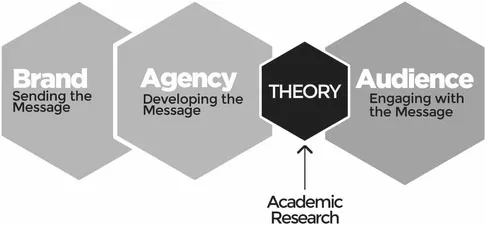
Introduction to Advertising
Understanding and Managing the Advertising Process
- 296 pages
- English
- ePUB (mobile friendly)
- Available on iOS & Android
About this book
This book is an introductory roadmap to the advertising process. Advertising is explored as a creative communication message from a brand, created by advertising agencies and distributed across different media to target the right consumers.
The book provides an understanding of the benefits of advertising, its role in the economy and, even more so, acknowledges that advertisements are not only about selling but also about effectively communicating a message. The creative and conceptual approach towards the communication process is discussed, and insight is presented into the dynamics within the industry and the different stakeholders involved, while recognising how different creative elements in advertisements are consciously selected to make them appealing. Finally, it considers how to analyse and measure an advert's effectiveness and looks ahead to future ideas and technologies arising in advertising. Effectively combining theory with practical insight, each chapter begins with learning objectives and ends with key learnings. International case studies feature throughout, including insights from British Gas, WPP, Audi and KFC, as well as other examples from smaller organisations and the non-profit sector.
Taking students step by step through the advertising process, it is important reading for undergraduate and postgraduate students studying Advertising, Brand Management, Marketing Communications and Media Planning.
Frequently asked questions
- Essential is ideal for learners and professionals who enjoy exploring a wide range of subjects. Access the Essential Library with 800,000+ trusted titles and best-sellers across business, personal growth, and the humanities. Includes unlimited reading time and Standard Read Aloud voice.
- Complete: Perfect for advanced learners and researchers needing full, unrestricted access. Unlock 1.4M+ books across hundreds of subjects, including academic and specialized titles. The Complete Plan also includes advanced features like Premium Read Aloud and Research Assistant.
Please note we cannot support devices running on iOS 13 and Android 7 or earlier. Learn more about using the app.
Information
Theme 1
Creating the message
2 The theories behind the message
Learning outcome
- Describe and explain the role of brands in the advertising process;
- Recognise the impor tance of theor y in advertisement design and development;
- Give examples of different theories related to advertising;
- Describe how the theories can be applied to advertisements;
- Summarise the concept of the theory behind the message.
Introduction
What are theories
Why theories?
- Theories are essential for explaining how things work. As earlier indicated, theories provide a background knowledge which explains how things work. It can be reassuring when you know that things will happen when you do something in a certain way. For the beginner, theories give the initial insight into how advertising works, what needs to be done to get an appropriate response and simplify complex advertising processes into an easily recollected model. For more experienced people, theories are there to be challenged. They are looking for ways to stretch the theories, have a better understanding and make impact.
- Theories are vital for academic work and theoretical advancement. As theories are often developed by academics, it is essential to feed that knowledge into the education system. Theories are developed and are further tested by other researchers to confirm their validity, and this is about theoretical advancement, which also feeds into practice. I have developed two theories as part of my research. My theory of emotional appeal recognises that when consumers are exposed to emotional appeal in advance, they acknowledge it but filter it through their personal filtration mechanism which is based on their personal experiences (Mogaji, 2018).
- Theories are essential for practice. Advertisers may often think that they know how things work but theory explains the concept behind it. As theories get developed by academics (in universities), these are applicable in the industry to make a practical impact.
- Theories are evolving. There is new knowledge every day as human behaviours evolve, so likewise the explanation for things around us. What was happening previously about how the consumer engages with advertisements may no longer be relevant to advertisements in society today. The theories are therefore changed or replaced if they are no longer able to explain the situation of things. More theories are being developed and shared with researchers and practitioners to test and further validate them (Hazarika & Zhang, 2019).
- Theories are often graphically illustrated. Though not compulsory, it is often the case that theories have images that graphically illustrate the statement and how the variables are interrelated. Most times, images used for advertisement explain the statement and message of an advert better than words could. This could be in the form of a linear connection, multiple connections with correlation and causal effects or grids. This is why some are called “frameworks” or “models”. Look at the examples that will be shared and consider their graphical representation, as this may assist in a better explanation of the situation.
The place of theory in the message

Advertising theories

- For the agency. These are the theories that shape their creative approach. These are also called practice-based theories. Advertisers can adapt the theory to shape how they will develop their advertising. The agencies’ understanding of the theory influences how they will decide to communicate the brands’ message (Melewar & Nguyen, 2014). An example is FCB grids which advise the agency to develop an advertisement in a way because of the level of involvement customers have when deciding to buy the product. Communications theory also puts the onus on the brand to encode their message and send it through the media while congruency theory expects the agency to adopt creative elements that their audience will engage with because it is in congruence with their personality.
- For the Audience. These are theories that explain how the audience deals with the advertisements when they receive them. These are also called information processing theories. Information processing is the way an observer of an event or phenomenon engages with the information and the decisions they make thereafter (Gong & Cummins, 2020). As such, it is a process that describes everything that happens to a phenomenon. In advertising, this theory recognises that the engagement with the advertisement is relative to individuals. Brands and advertisers do not have control over how their messages are being processed, but they can make an effort to make th...
Table of contents
- Cover
- Half Title
- Title Page
- Copyright Page
- Dedication
- Contents
- List of figures
- Acknowledgements
- Introduction
- THEME 1 Creating the message
- THEME 2 Sharing the message
- THEME 3 Engaging the message
- THEME 4 Evaluating the message
- Index